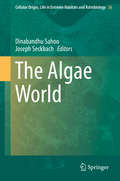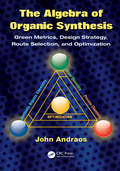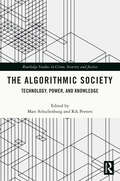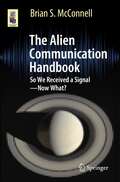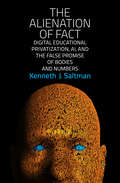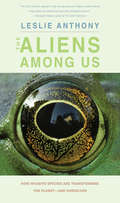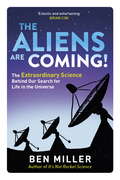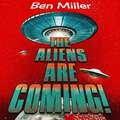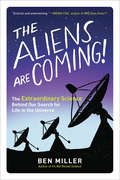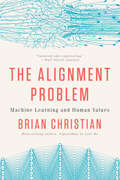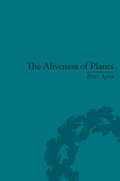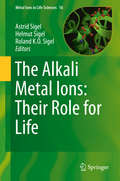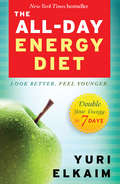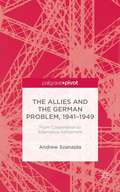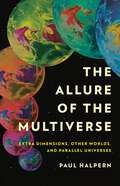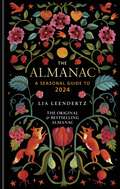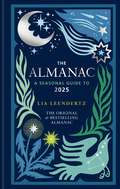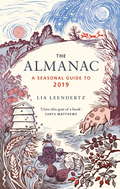- Table View
- List View
The Alga Dunaliella
by Ami Ben-Amotz Jürgen E.W. Polle D.V. Subba RaoThis volume presents a state-of-the art research in biochemistry, molecular biology and medical application. A glossary of specialized terms is appended. Each chapter is contributed by an expert or group of experts dedicated to increase our understanding of Dunaliella. All the chapters were reviewed internally by their colleagues, editors and external reviewers; this was followed by a final revision. The book provides a balanced multi-disciplinary communication and contributes to our understanding of this unique alga. It is addressed to graduate students and scientists as a summary of current thoughts on Dunaliella.
The Algae World
by Joseph Seckbach Dinabandhu SahooAlgal World has been carefully written and edited with an interdisciplinary appeal and aims to bring all aspects of Algae together in one volume. The 22 chapters are divided into two different parts which have been authored by eminent researchers from across the world. The first part, Biology of Algae, contains 10 chapters dealing with the general characteristics, classification and description of different groups such as Blue Green Algae, Green Algae, Brown Algae, Red Algae, Diatoms, Xanthophyceae, Dinophyceae, etc. In , it has two important chapters covering Algae in Extreme Environments and Life Histories and Growth Forms in Green Algae. The second part, Applied Phycology, contains 12 chapters dealing with the more applied aspects ranging from Algal Biotechnology, Biofuel, Phycoremediation, Bioactive Compounds, Biofertilizer, Fatty Acids, Harmful Algal Blooms, Industrial Applications of Seaweeds, Nanotechnology, Phylogenomics and Algal culture Techniques, etc.
The Algebra of Organic Synthesis: Green Metrics, Design Strategy, Route Selection, and Optimization
by John AndraosThe Algebra of Organic Synthesis combines the aims, philosophies, and efforts involved in organic synthesis, reaction optimization, and green chemistry with techniques for determining quantitatively just how "green" synthesis plans are. It provides the first complete quantitative description of synthesis strategy analysis in the context of green ch
The Algorithmic Society: Technology, Power, and Knowledge (Routledge Studies in Crime, Security and Justice)
by Marc Schuilenburg Rik PeetersWe live in an algorithmic society. Algorithms have become the main mediator through which power is enacted in our society. This book brings together three academic fields – Public Administration, Criminal Justice and Urban Governance – into a single conceptual framework, and offers a broad cultural-political analysis, addressing critical and ethical issues of algorithms. Governments are increasingly turning towards algorithms to predict criminality, deliver public services, allocate resources, and calculate recidivism rates. Mind-boggling amounts of data regarding our daily actions are analysed to make decisions that manage, control, and nudge our behaviour in everyday life. The contributions in this book offer a broad analysis of the mechanisms and social implications of algorithmic governance. Reporting from the cutting edge of scientific research, the result is illuminating and useful for understanding the relations between algorithms and power.Topics covered include: Algorithmic governmentality Transparency and accountability Fairness in criminal justice and predictive policing Principles of good digital administration Artificial Intelligence (AI) in the smart city This book is essential reading for students and scholars of Sociology, Criminology, Public Administration, Political Sciences, and Cultural Theory interested in the integration of algorithms into the governance of society.
The Alien Communication Handbook: So We Received a Signal—Now What? (Astronomers' Universe)
by Brian S. McConnellScientists have been searching for signals from extraterrestrial civilizations since Frank Drake’s first radio survey in 1960. But what would actually happen if SETI’s search succeeds? Is there any way we could even make sense of the signal we receive? Written by an expert in communication systems and translation technology, this book explores the science of interstellar communication. It explains how this process may unfold, how an ET communication link would work, the types of information it could convey and how professionals, amateurs and ordinary people like you would participate in the effort to understand what another civilization has to say. Along the way, the book introduces readers to many aspects of modern-day communication systems and computing. Featured as well are dozens of illustrations, photos and real-world examples, rounding out this compelling foray into the mechanics of interstellar communication. “Scientists, policy makers, and all interested in the likely future discovery of alien life will want to read this book.” - Steven J. Dick, Former NASA Chief Historian
The Alien Probe (Tom Swift III, Book #3)
by Victor AppletonFrom the back of the book: When a mysterious and top-secret alien probe, which Tom found on Jupiter, is stolen from Swift Enterprises, Tom Swift rockets into another exciting mission. The information locked in the probe is invaluable, and Tom must find it at all costs. He and his friends, Anita and Ben, chase the thief through underground caverns and, using their high-powered space-ships, through the blackness of space--risking everything they have to find the alien probe and reveal its secrets.
The Alienation of Fact: Digital Educational Privatization, AI, and the False Promise of Bodies and Numbers
by Kenneth J. SaltmanAn investigation of the role of educational privatization and technology in the crises of truth and agency.Today, conspiracy theories run rampant, attacks on facts have become commonplace, and systemic inequities are on the rise as individual and collective agency unravels. The Alienation of Fact explains the educational, technological, and ideological preconditions for these contemporary crises of truth and agency and explores the contradictions and competing visions for the future of education that lie at the center of the problem. Schools are increasingly reimagined as businesses, and high-stakes standardized testing and curricula, for-profit charter schools, and the rise of educational AI put capital and technology at the center of education. Yet even as our society demands measure, data, and facts, politicians and news outlets regularly make unfounded assertions. How should we make sense of the contradictions between the demand for radical data-driven empiricism and the flight from evidence, argument, or theoretical justification? In this critical investigation of the new digital directions of educational privatization—AI education, adaptive learning technology, biometrics, the quantification of play and social emotional learning—and the politics of the body, Saltman shows how the false certainty of bodies and numbers replaces deliberative and thoughtful agency in a time of increasing precarity. A distinctive contribution to scholarship on public school privatization and educational technology, politics, policy, pedagogy, and theory, The Alienation of Fact is a spirited call for democratic education that values creating a society of &“thinking people&” over capitalistic gains.
The Aliens Among Us: How Invasive Species Are Transforming the Planet—and Ourselves
by Leslie AnthonyA thoughtful, accessible look at the rapidly growing issue of invasive plants, animals, and microbes around the globe with a focus on the scientific issues and ecological, health, and other challenges From an award-winning adventure and science journalist comes an eye-opening exploration of a burgeoning environmental phenomenon and the science coalescing around it. Leslie Anthony leads readers on adventures physical and philosophical as he explores how and why invasive species are hijacking ecosystems around the globe. Weaving science, travel, history, and humor with diverse examples to chart and describe the phases of species invasion and human response, Anthony introduces field researchers and managers who seek to understand the biological, social, and economic aspects of this complex issue, and whose work collectively suggests the emergence of a global shadow economy centered on invasives. With tales of pythons in the Everglades, Asian carp and lamprey in the Great Lakes, Japanese knotweed seemingly everywhere, and the invasive organisms we don’t see—pathogens and microbes such as the Zika virus—this book rivets attention on a new ecological reality.
The Aliens Are Coming!: The Exciting and Extraordinary Science Behind Our Search for Life in the Universe
by Ben MillerDiscover the fascinating and cutting-edge science behind the greatest question of all: is there life beyond Earth? For millennia, we have looked up at the stars and wondered whether we are alone in the universe. In the last few years, scientists have made huge strides towards answering that question. In The Aliens are Coming!, comedian and bestselling science writer Ben Miller takes us on a fantastic voyage of discovery, from the beginnings of life on earth to the very latest search for alien intelligence. What soon becomes clear is that the hunt for extra-terrestrials is also an exploration of what we actually mean by life. What do you need to kickstart life? How did the teeming energy of the Big Bang end up as frogs, trees and quantity surveyors? How can evolution provide clues about alien life? What might it look like? (Probably not green and sexy, sadly.) As our probes and manned missions venture out into the solar system, and our telescopes image Earth-like planets with ever-increasing accuracy, our search for alien life has never been more exciting - or better funded. The Aliens are Coming! is a comprehensive, accessible and hugely entertaining guide to that search, and our quest to understand the very nature of life itself.
The Aliens Are Coming!: The Exciting and Extraordinary Science Behind Our Search for Life in the Universe
by Ben MillerDiscover the fascinating and cutting-edge science behind the greatest question of all: is there life beyond Earth? For millennia, we have looked up at the stars and wondered whether we are alone in the universe. In the last few years, scientists have made huge strides towards answering that question. In The Aliens are Coming!, comedian and bestselling science writer Ben Miller takes us on a fantastic voyage of discovery, from the beginnings of life on earth to the very latest search for alien intelligence. What soon becomes clear is that the hunt for extra-terrestrials is also an exploration of what we actually mean by life. What do you need to kickstart life? How did the teeming energy of the Big Bang end up as frogs, trees and quantity surveyors? How can evolution provide clues about alien life? What might it look like? (Probably not green and sexy, sadly.) As our probes and manned missions venture out into the solar system, and our telescopes image Earth-like planets with ever-increasing accuracy, our search for alien life has never been more exciting - or better funded. The Aliens are Coming! is a comprehensive, accessible and hugely entertaining guide to that search, and our quest to understand the very nature of life itself.
The Aliens Are Coming!: The Extraordinary Science Behind Our Search for Life in the Universe
by Ben MillerActor and bestselling science writer Ben Miller takes readers to the cutting edge of one of the greatest questions of all: Is there life beyond Earth? For millennia, we have looked up at the stars and wondered whether we are alone in the universe, but in the last few years—as our probes begin to escape the solar system, and our telescopes reveal thousands of Earthlike planets—scientists have taken huge leaps toward an answer. “Forget science fiction,” author Ben Miller writes. “We are living through one of the most extraordinary revolutions in the history of science: the emergent belief of a generation of physicists, biologists, and chemists that we are not alone.” The Aliens Are Coming! is a refreshingly clear, hugely entertaining guide to the search for alien life. Miller looks everywhere for insight, from the Big Bang’s sea of energy that somehow became living matter, to the equations that tell us Earth is not so rare, to the clues bacteria hold to how life started. And he makes the case that our growing understanding of life itself will help us predict whether it exists elsewhere, what it might look like, and when we might find it.
The Alignment Problem: Machine Learning And Human Values
by Brian ChristianA jaw-dropping exploration of everything that goes wrong when we build AI systems and the movement to fix them. Today’s “machine-learning” systems, trained by data, are so effective that we’ve invited them to see and hear for us—and to make decisions on our behalf. But alarm bells are ringing. Recent years have seen an eruption of concern as the field of machine learning advances. When the systems we attempt to teach will not, in the end, do what we want or what we expect, ethical and potentially existential risks emerge. Researchers call this the alignment problem. Systems cull résumés until, years later, we discover that they have inherent gender biases. Algorithms decide bail and parole—and appear to assess Black and White defendants differently. We can no longer assume that our mortgage application, or even our medical tests, will be seen by human eyes. And as autonomous vehicles share our streets, we are increasingly putting our lives in their hands. The mathematical and computational models driving these changes range in complexity from something that can fit on a spreadsheet to a complex system that might credibly be called “artificial intelligence.” They are steadily replacing both human judgment and explicitly programmed software. In best-selling author Brian Christian’s riveting account, we meet the alignment problem’s “first-responders,” and learn their ambitious plan to solve it before our hands are completely off the wheel. In a masterful blend of history and on-the ground reporting, Christian traces the explosive growth in the field of machine learning and surveys its current, sprawling frontier. Readers encounter a discipline finding its legs amid exhilarating and sometimes terrifying progress. Whether they—and we—succeed or fail in solving the alignment problem will be a defining human story. The Alignment Problem offers an unflinching reckoning with humanity’s biases and blind spots, our own unstated assumptions and often contradictory goals. A dazzlingly interdisciplinary work, it takes a hard look not only at our technology but at our culture—and finds a story by turns harrowing and hopeful.
The Aliveness of Plants: The Darwins at the Dawn of Plant Science
by Peter AyresThe Darwin family was instrumental in the history of botany. Their experiences illustrate the growing specialization and professionalization of science in the nineteenth century. The author shows how botany escaped the burdens of medicine, feminization and the sterility of classification and nomenclature to become a rigorous laboratory science.
The Alkali Metal Ions: Their Role for Life
by Astrid Sigel Helmut Sigel Roland K. O. SigelMILS-16 provides an up-to-date review of the impact of alkali metal ions on life. Their bioinorganic chemistry and analytical determination, the solid state structures of bio-ligand complexes and the properties of alkali metal ions in solution in the context of all kinds of biologically relevant ligands are covered, this includes proteins (enzymes) and nucleic acids (G-quadruplexes). Minerals containing sodium (Na+) and potassium (K+) are abundant in the Earth's crust, making Na+ and K+ easily available. In contrast, the alkali elements lithium (Li+), rubidium, and cesium are rare and the radioactive francium occurs only in traces. Since the intra- and extracellular, as well as the compartmental concentrations of Na+ and K+ differ significantly, homeostasis and active transport of these ions are important; this involves transporters/carriers and pore-forming ion channel proteins. Systems like Na+/K+-ATPases, H+/K+-ATPases or Na+/H+ antiporters are thoroughly discussed. The role of K+ in photosynthesis and the role of Na+ in charging the "battery of life" are pointed out. Also, the relationships between alkali metal ions and diseases (e. g. , Parkinson or traumatic brain injury) are covered and the relevance of Li+ salts in medicine (pharmacology and mechanism) is reviewed. This and more is treated in an authoritative and timely manner in the 16 stimulating chapters of Volume 16, The Alkali Metal Ions: Their Role for Life, which are written by 44 internationally recognized experts from 12 nations. The impact of this vibrant research area is manifested in nearly 3000 references, over 30 tables and more than 150 illustrations (two thirds in color). MILS-16 also provides excellent information for teaching. Astrid Sigel, Helmut Sigel, and Roland K. O. Sigel have long-standing interests in Biological Inorganic Chemistry. Their research focuses on metal ion interactions with nucleotides and nucleic acids and on related topics. They edited previously 44 volumes in the series Metal Ions in Biological Systems.
The All-Day Energy Diet: Double Your Energy In 7 Days
by Yuri ElkaimThe All-Day Energy Diet helps busy, everyday people enjoy more energy, improve their health, and lose weight by restoring their bodies' optimal vitality through five natural solutions: Real food Restorative supplementation Adrenal, stress, and hormonal support Digestive repair Proper exercise By implementing any one (or all) of these strategies, you can expect to double your energy, while enjoying easier weight loss and looking and feeling younger.
The Allegheny Woodrat
by John Peles Janet WrightA decline in populations of Allegheny woodrats (Neotoma magister) was first noticed in the 1980s. Since that time, woodrats have become extirpated from at least two states and have declined dramatically in several others. Recent evidence suggests that the decline of this species may be proceeding further south to include states where woodrat populations were previously considered to be stable. The Allegheny Woodrat: Ecology, Conservation, and Management of a Declining Species provides a comprehensive summary of research conducted over the past twenty-five years. The book integrates the results of this research into a comprehensive picture of the ecological requirements, conservation principles, and management strategies for this declining species. In addition, general principles learned from the study of woodrats are applied to the conservation and management of other declining species, including other species of Neotoma. The editors and chapter authors are researchers from both academic settings and state management agencies, individuals who have contributed significantly to the study of Allegheny woodrats during the past two decades. The book will be of interest to ecologists, conservation biologists, wildlife professionals, and students.
The Allies and the German Problem, 1941–1949: From Cooperation to Alternative Settlement
by Andrew SzanajdaThe Allies and the German Problem, 1941-1949 examines Allied policymaking during the Second World War and the military occupation of postwar Germany, demonstrating how the initial unity of the Allies disintegrated during the postwar military occupation in the face of their separate goals for postwar Germany and Europe.
The Allure of the Multiverse: Extra Dimensions, Other Worlds, and Parallel Universes
by Paul Halpern&“A rich and rewarding history of one of the most astounding ideas in physics and astronomy&” (Marcia Bartusiak) – that the universe we know isn&’t the only one Our books, our movies—our imaginations—are obsessed with extra dimensions, alternate timelines, and the sense that all we see might not be all there is. In short, we can&’t stop thinking about the multiverse. As it turns out, physicists are similarly captivated. In The Allure of the Multiverse, physicist Paul Halpern tells the epic story of how science became besotted with the multiverse, and the controversies that ensued. The questions that brought scientists to this point are big and deep: Is reality such that anything can happen, must happen? How does quantum mechanics &“choose&” the outcomes of its apparently random processes? And why is the universe habitable? Each question quickly leads to the multiverse. Drawing on centuries of disputation and deep vision, from luminaries like Nietzsche, Einstein, and the creators of the Marvel Cinematic Universe, Halpern reveals the multiplicity of multiverses that scientists have imagined to make sense of our reality. Whether we live in one of many different possible universes, or simply the only one there is, might never be certain. But Halpern shows one thing for sure: how stimulating it can be to try to find out.
The Almanac: A Seasonal Guide To 2018 (Almanac)
by Lia LeendertzTHE ORIGINAL & BESTSELLING ALMANACReconnect with the seasons in Britain and Ireland with this month-by-month guide to the world around us - including tide tables, sunrises and moon phases; garden feasts, wildlife and folklore; seasonal recipes, snacks and more.The Almanac: A Seasonal Guide to 2024 gives you the tools and inspiration you need to celebrate, mark and appreciate each month of the year in your own particular way.Divided into the 12 months, a set of tables each month gives it the feel and weight of a traditional almanac, providing practical information that gives access to the outdoors and the seasons, perfect for expeditions, meteor-spotting nights and beach holidays. This year's edition focuses on the natural wonders of the garden, celebrating the beautiful flora and fauna at your doorstep. There are also features on each month's unique nature, plus a flower and a snack of the month.You will find yourself referring to The Almanac all year long, revisiting it again and again, and looking forward to the next edition as the year draws to a close.PRAISE FOR THE ALMANAC:'Lia Leendertz's classic almanac never fails to delight' - The Herald'It's a perfect Christmas present' - Allan Jenkins, The Observer'The perfect companion to the seasons' - India Knight'Indispensable' - Sir Bob Geldof'This book is your bible' - The Independent'I love this gem of a book' - Cerys Matthews
The Almanac: A Seasonal Guide To 2018 (Almanac)
by Lia LeendertzTHE ORIGINAL & BESTSELLING ALMANACReconnect with the seasons in Britain and Ireland with this month-by-month guide to the world around us - including tide tables, sunrises and moon phases; garden feasts, wildlife and folklore; seasonal recipes, snacks and more.The Almanac: A Seasonal Guide to 2024 gives you the tools and inspiration you need to celebrate, mark and appreciate each month of the year in your own particular way.Divided into the 12 months, a set of tables each month gives it the feel and weight of a traditional almanac, providing practical information that gives access to the outdoors and the seasons, perfect for expeditions, meteor-spotting nights and beach holidays. This year's edition focuses on the natural wonders of the garden, celebrating the beautiful flora and fauna at your doorstep. There are also features on each month's unique nature, plus a flower and a snack of the month.You will find yourself referring to The Almanac all year long, revisiting it again and again, and looking forward to the next edition as the year draws to a close.PRAISE FOR THE ALMANAC:'Lia Leendertz's classic almanac never fails to delight' - The Herald'It's a perfect Christmas present' - Allan Jenkins, The Observer'The perfect companion to the seasons' - India Knight'Indispensable' - Sir Bob Geldof'This book is your bible' - The Independent'I love this gem of a book' - Cerys Matthews
The Almanac: A Seasonal Guide To 2018 (Almanac)
by Lia LeendertzThe original and bestselling almanacReconnect with the seasons in Britain and Ireland with this month-by-month guide to the world around us - including tide tables, sunrises and moon phases; wildlife and folklore; seasonal recipes and more.The Almanac: A Seasonal Guide to 2025 gives you the tools and inspiration you need to celebrate, mark and appreciate each month of the year in your own particular way.Divided into the 12 months, a set of tables each month gives it the feel and weight of a traditional almanac, providing practical information that gives access to the outdoors and the seasons, perfect for expeditions, meteor-spotting nights and beach holidays. And it's the ideal gift!You will find yourself referring to The Almanac all year long, revisiting it again and again, and looking forward to the next edition as the year draws to a close.PRAISE FOR THE ALMANAC:'Lia Leendertz's classic almanac never fails to delight' - The Herald'It's a perfect Christmas present' - Allan Jenkins, The Observer'The perfect companion to the seasons' - India Knight'Indispensable' - Sir Bob Geldof'This book is your bible' - The Independent'I love this gem of a book' - Cerys Matthews
The Almanac: A Seasonal Guide To 2018 (Almanac)
by Lia LeendertzThe original and bestselling almanacReconnect with the seasons in Britain and Ireland with this month-by-month guide to the world around us - including tide tables, sunrises and moon phases; wildlife and folklore; seasonal recipes and more.The Almanac: A Seasonal Guide to 2025 gives you the tools and inspiration you need to celebrate, mark and appreciate each month of the year in your own particular way.Divided into the 12 months, a set of tables each month gives it the feel and weight of a traditional almanac, providing practical information that gives access to the outdoors and the seasons, perfect for expeditions, meteor-spotting nights and beach holidays. And it's the ideal gift!You will find yourself referring to The Almanac all year long, revisiting it again and again, and looking forward to the next edition as the year draws to a close.PRAISE FOR THE ALMANAC:'Lia Leendertz's classic almanac never fails to delight' - The Herald'It's a perfect Christmas present' - Allan Jenkins, The Observer'The perfect companion to the seasons' - India Knight'Indispensable' - Sir Bob Geldof'This book is your bible' - The Independent'I love this gem of a book' - Cerys Matthews
The Almanac: A Seasonal Guide to 2019
by Lia LeendertzTHE ORIGINAL & BESTSELLING ALMANAC 'I love this gem of a book' - Cerys Matthews 'This book is your bible' - The Independent '...it already feels like an annual necessity' - India Knight'Joyous' - Allan Jenkins'Updated for 2019 with more lovely ideas to celebrate the seasons' - Gardens Illustrated'A charming book. This is a real gem of a gift' - Sunday Express, S Magazine. A perfect toolkit connecting with the world around us and the year ahead as it unfolds - all in a compact and pocket size that just begs you to pick it up and browse - Reckless Gardener or Its range of information and depth of understanding of our seasons is priceless - Reckless GardenerThe Almanac: A Seasonal Guide to 2019 reinvents the tradition of the rural almanac for a new audience. It gives you the tools and inspiration you need to celebrate, mark and appreciate each month of the year in your own particular way. Divided into the 12 months, a set of tables each month gives it the feel and weight of a traditional almanac, providing practical information that gives access to the outdoors and the seasons, perfect for expeditions, meteor-spotting nights and beach holidays. There are also features on each month's unique nature, such as the meteor shower of the month, beehive behaviour, folklore and stories, seasonal recipes and charts tracking moon phases and tides. Why not try identifying trees by their bare buds in January; Enjoy Buttermilk scones with orangle blossom & honey butter in June; Discover the Chinese New Year story of 'The great race' in February.You will find yourself referring to the almanac all year long, revisiting it again and again, and looking forward to the next edition as the year draws to a close.Praise for The Almanac: A Seasonal Guide to 2018:'The perfect companion to the seasons' - India Knight'A richly layered book of events, celebrations and everyday information that together create a beautiful, fascinating resource . . . In the single month I've had my hands on it, the book has quietly "worked".' - Telegraph'Beautifully written, this pocket-sized guide is a labour of love and will remind you to appreciate little moments throughout the year.' - Gardens Illustrated'Elegant . . . an ideal stocking filler.' - The English Garden
The Almanac: A Seasonal Guide to 2019
by Lia LeendertzTHE ORIGINAL & BESTSELLING ALMANAC 'I love this gem of a book' - Cerys Matthews 'This book is your bible' - The Independent '...it already feels like an annual necessity' - India Knight'Joyous' - Allan Jenkins'Updated for 2019 with more lovely ideas to celebrate the seasons' - Gardens Illustrated'A charming book. This is a real gem of a gift' - Sunday Express, S Magazine. A perfect toolkit connecting with the world around us and the year ahead as it unfolds - all in a compact and pocket size that just begs you to pick it up and browse - Reckless Gardener or Its range of information and depth of understanding of our seasons is priceless - Reckless GardenerThe Almanac: A Seasonal Guide to 2019 reinvents the tradition of the rural almanac for a new audience. It gives you the tools and inspiration you need to celebrate, mark and appreciate each month of the year in your own particular way. Divided into the 12 months, a set of tables each month gives it the feel and weight of a traditional almanac, providing practical information that gives access to the outdoors and the seasons, perfect for expeditions, meteor-spotting nights and beach holidays. There are also features on each month's unique nature, such as the meteor shower of the month, beehive behaviour, folklore and stories, seasonal recipes and charts tracking moon phases and tides. Why not try identifying trees by their bare buds in January; Enjoy Buttermilk scones with orangle blossom & honey butter in June; Discover the Chinese New Year story of 'The great race' in February.You will find yourself referring to the almanac all year long, revisiting it again and again, and looking forward to the next edition as the year draws to a close.Praise for The Almanac: A Seasonal Guide to 2018:'The perfect companion to the seasons' - India Knight'A richly layered book of events, celebrations and everyday information that together create a beautiful, fascinating resource . . . In the single month I've had my hands on it, the book has quietly "worked".' - Telegraph'Beautifully written, this pocket-sized guide is a labour of love and will remind you to appreciate little moments throughout the year.' - Gardens Illustrated'Elegant . . . an ideal stocking filler.' - The English Garden
The Almanac: A Seasonal Guide to 2021
by Lia Leendertz'The perfect companion to the seasons' - India KnightWelcome to The Almanac: A Seasonal Guide to 2021. If you are new to The Almanac then welcome; if you are a regular reader then hello! The Almanac is about celebrating the unfolding year in all its various facets. The old dependables which I include every year are back: moon phases, sun rises and sets, tide time tables and the sky at night. As ever there are seasonal recipes and monthly gardening tips for the flower and vegetable garden too, as well as a bit of folklore, and nature and a song for each month.This year's edition has a theme: movement, migration and pilgrimage. This was not a reaction to the unsettling events of last year - it was half written by the time Covid-19 hit - but writing it from lockdown did give me a heightened appreciation of the way in which Britain and Ireland have always and continue to be places of movement, and are intimately connected to the rest of the world. You will find within this book migration tales for each month of this year, but I have also searched out seasonal tales of human movement, and included a pilgrimage for each month, some ancient, some current, all underlining the spiritual benefits of putting one foot in front of the other. Every month I have included a method of navigating using the stars, sun or moon, so you can find your way around in the dark (or just look out of your window and know where south is). And our monthly folk songs are all shanties this year, work songs with movement at their very heart, created to coordinate muscle power to drive sailing ships backwards and forwards across the Atlantic Ocean, and containing influences from the eastern seaboard of the US down to the Caribbean and beyond mixed with British and Irish folk traditions. These songs are stitched through with movement and travel, as is this Almanac.PRAISE FOR THE ALMANAC: A SEASONAL GUIDE'This book is your bible' - The Independent'An ideal stocking filler' - The English Garden'I love this gem of a book' - Cerys Matthews'Indispensable' - Sir Bob Geldof'An uplifting nature-inspired guide' - Country & Town House magazine

